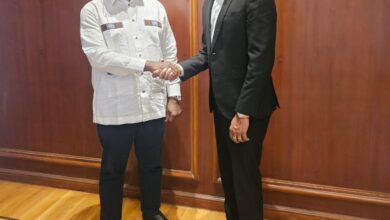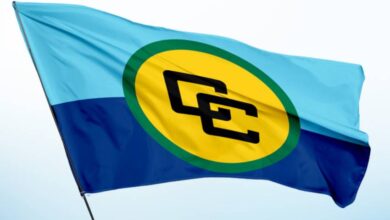I am honoured to be here at the Schomburg Center for Research in Black Culture, an institution which stands as testament to the strong historical ties between the Caribbean and the African-American community. Named after a Black Caribbean man, the Schomburg Center has been the home of Caribbean and African-American culture and history, and of all peoples of the African Diaspora, since Arturo Alphonso Schomburg, a Black man from Puerto Rico, first became associated with it in the early part of the 20th Century. And, here we are in Harlem to discuss the idea of forging closer ties between the Caribbean and the African-American community.
We are not now starting a new process. We aim to build upon the foundation which has been constructed over a period spanning more than a century of collaboration and cooperation. To put this in perspective, please join me on a brief trip into the historical legacy Harlem has bequeathed to us. Having a sense of the strong historical ties forged between us will help guide our quest for closer ties in the future.
The Caribbean community in the United States is diverse. In the early history of the Caribbean we saw ourselves narrowly defined as citizens of the former British colonies – the English-speaking islands of the Caribbean, Belize in Central America and Guyana in South America. Now, when we speak of the Caribbean in the context of CARICOM we have become more diverse and we now include Dutch-speaking Suriname and some eight million French/Creole-speaking Haitians. The addition of Suriname and Haiti to the CARICOM family has further enriched our culture and we have become more diverse, reflected, also, in our ethnic and racial composition.
In as much as Harlem holds an important place in the history of the African-American community it also has significant historical significance for the Caribbean community in the United States and to the Caribbean region. It was right here in Harlem that many citizens of the Caribbean migrated and left their mark on the history of America in general and on the history of the African-American community in particular. The connection – the link – between these two communities has been strong and enduring. It has stood the test of time. Our presence here today as leaders of independent Caribbean nations is testament to this bond between us. The road we have travelled together; the struggles we have joined in together is testament to the strength of our historical bond, and confirms our commitment to work together in the future, as we have worked together in the past for the advancement of our peoples.
Our history of working side-by-side together is a long one. Throughout the years Caribbean immigrants and their descendants have assimilated into American society to the extent where the US Census Bureau now counts most people of West Indian descent as African-Americans. While we know there are more than five million people of West Indian descent in the United States, the official census data has that number at just over 2 ½ million. We have at least one million in New York alone. Except for those who migrated from the Caribbean and still retain a Caribbean accent, we speak a common language with the African-American community, descendants of Caribbean immigrants have adopted and shared in the African-American experience and our cultures have greatly influenced each other.
When Marcus Mosiah Garvey first set foot in America in 1916 he settled in Harlem after travelling throughout the United States. Here he built the largest Black movement in the history of the United States, the UNIA, at that time, dedicated to uplifting of Black people here in the United States and around the world. Garvey’s philosophy spanned cultural, political and economic advancement. While visiting Jamaica in June 1965, the Rev. Dr. Martin Luther King, Jr., paid tribute to Garvey’s contribution to the African-American community by stating in part, and I quote:
“Marcus Garvey was the first man of color in the history of the United States to lead and develop a mass movement. He was the first man, on a large scale, and level, to give millions of Negroes a sense of dignity and destiny, and make the Negro feel that he was somebody. You gave Marcus Garvey to the United States of America, and he gave to the millions of Negroes in the United States a sense of personhood, a sense of manhood, and a sense of somebodiness.”
Marcus Garvey was vilified and prosecuted for his advocacy and his work to advance the lot of Black people everywhere. But, Garvey inspired many of the political leaders of Africa and the Caribbean in removing their countries from under the yolk of colonialism in the second half of the 20th Century. Many Black leaders to follow were influenced by Garvey’s movement. Among them were Elijah Mohammed and Malcolm X, whose father, along with Elijah Mohammed, were officers in Garvey’s movement.
Some eight months before his assassination in 1964, Malcolm stated (quote):
“Every time you see another nation on the African continent become independent, you know that Marcus Garvey is alive. It was Marcus Garvey’s philosophy of Pan-Africanism that initiated the entire freedom movement, which brought about the independence of African nations. And had it not been for Marcus Garvey, and the foundations laid by him, you would find no independent nations in the Caribbean today….”
It was from here in Harlem that Garvey inspired many of our forefathers around the world to reach out for new levels of participation in their governance and economic advancement. It is here in Harlem that we now seek to forge closer ties between the modern Caribbean and the African-American community. Ties which we believe can benefit both of our peoples and the generation that follows.
Our relationship in the United States transcends the geographic boundaries which sometimes act against greater synergy between us. But our Caribbean migrant community has not allowed any obstacle to prevent them from being a part of African-American experience. And this goes back long before Garvey had an impact on Harlem and the African Diaspora. Almost 100 years before Garvey set foot in Harlem, there was John Brown Russworm, who in 1826 became the first Black college graduate in the history of the United States. Having received his degree from Bowdoin College in Maine, Russworm opened the door to a higher education for Black people in America. Not only was Russworm the first Black college graduate in the history of the United States, he also co-founded and was editor of Freedom Journal, the first Black newspaper to be published in America right here in New York City in 1827. Freedom Journal became a voice of Black people and gave expression to their quest for freedom and equality here in America and around the world. Russworm’s contribution to the publishing press earned him the reputation as the father of the Black Press in America.
Since that time, Harlem has been home to many nationals of the Caribbean who have lived and contributed to its social, literary, cultural and economic history. The great novelist, poet and freedom fighter Claude Mackay who preceded Garvey to Harlem by a few years contributed to what is often referred to as the Harlem Renaissance. Famed actors Sidney Poitier and Harry Belafonte built their early acting experiences in Harlem, right here on stage at the Schomburg. General Colin Powell, a son of Caribbean immigrants, was born and grew up in Harlem. Over the years, Caribbean people played important roles in the struggle for civil rights in the United States. People like Belafonte provided considerable financial support to Dr. King’s movement and Cleveland Williams was put in charge of organizing the historical march on Washington in 1963. Others marched in the streets of the south and sat at segregated lunch counters.
Throughout America’s history, thousands of persons of West Indian heritage have been serving side-by-side with their African-American brothers and sisters, in the segregated U.S. military to today’s uniformed forces, with bravery and honor and have given the ultimate sacrifice to protect the US homeland. Our history of military service even predates the founding of the United States, with Samuel Fraunces a Caribbean man serving with George Washington and was cited by Washington for “constant friendship and attention to the cause of our country and freedom.” In 1763, Fraunces opened a tavern at Broad and Pearl Streets in New York City, later known as Fraunces Tavern, it became highly popular and Fraunces soon made a reputation as New York’s best innkeeper. Fraunces Tavern is a little known historical landmark in New York City.
We also know that Malcolm X, influenced by his Caribbean heritage, was one of America’s foremost Black leaders of the twentieth century. His mother, Louise Little was born in Grenada. Malcolm himself spoke of his Caribbean heritage with great pride. He said, (and I quote)
[Y]ou will find that most West Indians, most people in the Caribbean area, are still proud that they are black, proud of the African blood, and their heritage; and I think this type of pride was instilled in my mother, and she instilled it in us, too, to the best degree she could.
There were many unheralded Caribbean immigrants who made significant contributions to the development of the United States during the early part of the twentieth century. Very little is recorded of their works and deeds. Many were entrepreneurs and innovators. Among these men and women was Richard Benjamin Moore, who also arrived in New York a few years before Marcus Garvey. An active member of Garvey’s movement, Moore was actively involved in political organizing. He was also a business pioneer and was associated with a company that introduced the first Multigraph and Linotype machines to Harlem. Moore unsuccessfully contested elections for Congress and for the New York State Assembly as well as for state Attorney-General of New York. After his unsuccessful bid for elected office, Moore turned his attention to organizing the West Indian community in New York in support of self-determination and independence for Caribbean Nations.
Others such as W. A. Domingo advocated for an end to colonialism and for Caribbean independence, while living in New York and, from here, significantly influenced the political development of the Caribbean.
Between World War I and the Depression, some 100,000 West Indians settled in the United States, mostly in New York and Boston. When they arrived they suffered the same discrimination suffered by the African-American community. In recent years, there has been an increased demand for our trained, skilled and experienced professionals. The New York school system has been recruiting hundreds of Caribbean teachers.
New York has been and continues to be the area from which many of our West Indian compatriots have launched their careers. It was in New York that the Hon. James S. Watson successfully campaigned for Municipal Court Judge in 1930, becoming one of the first two justices of African descent elected to judicial office in New York City. His daughter, Barbara M. Watson, was the first woman and the first Black person to achieve the rank of Assistant Secretary of State – serving in the administrations of Presidents Johnson, Nixon, Ford, and Carter as Assistant Secretary of State for Consular Affairs. Judge Watson’s son, James L. Watson, served as a Senior Judge on the United States Court of International Trade after serving in the New York State Senate and as a judge of the New York City Civil Court. His heroic military service in World War II earned him several medals including the Purple Heart.
This tradition of achievement by Caribbean-Americans is further exemplified by the illustrious political career of Shirley Chisholm, the first woman to seriously seek the nomination of a political party for president of the United States. And, the first Caribbean-born woman ever to serve in the New York City Legislature, the Hon. Una Clarke, is well known in modern New York politics for her civic activism which spanned more than three decades in diverse fields ranging from labor and early childhood education to immigrants rights and the struggle for empowerment of women and minorities. Her daughter, Yvette Clarke, who succeeded her in the New York City Legislature, now serves in the US Congress. Also in New York, right here in Harlem, Basil Paterson was the first Black person to serve as Secretary of State for the State of New York, and his son David Paterson now serves as the first African-American Governor of the State of New York.
As I started out saying: It is our hope that we can build on our history and the legacies our forebears have bequeathed to us, and forge closer ties between the Caribbean and the African-American community. In the same way we have worked together in the past we can share a common pathway to future prosperity that mutually benefits our two communities. We can take our relationship to another level. We can grow our relationship to advance the economic well-being of the Caribbean and the African-American community.
We have a lot to offer each other. The Caribbean brand enjoys great reputation and is known throughout the world. The spending power of the African-American community exceeds the budget of many of the islands of the Caribbean. The United States is the Caribbean’s number one trading partner. There is a constant two-way flow of goods and services between the region and the United States. Our markets for export and import are wide open. Our capital markets offer opportunities for high returns on investments. Our laws protect foreign and domestic investments. It is our hope, indeed it is our desire that the African-American community will take advantage of the many investment opportunities we offer in the diverse economies of the Caribbean. And, we want you to share in our world renowned tourism products. African-American visitor arrivals in the Caribbean are increasing. We seek significant growth in this area. We want to welcome you as visitors to our Region. We want you to come and enjoy the warmth of our hospitality, our sunshine, beautiful beaches, rivers, forests and culture.
I thank you.





